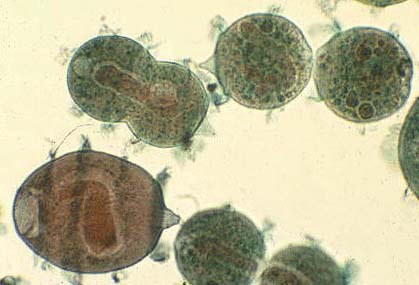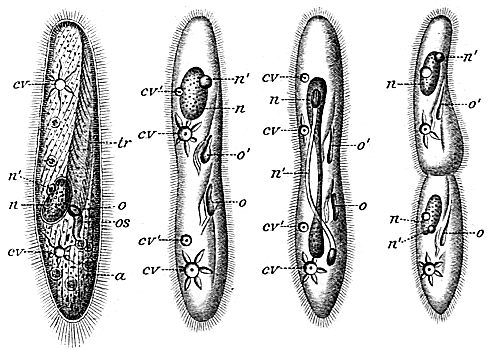







Most ciliates are free-living forms. Relatively few are parasitic, and only one species, Balantidium coli, is known to cause human disease. Some other ciliates cause diseases in fish and may present a problem for aquaculturists; others are parasites or commensals on various invertebrates. Still others live in great numbers in the digestive tracts of many hoofed mammals, where they serve to stabilize the large populations of symbiotic bacteria that break down cellulose in the animals' food.

Free-living ciliates may feed on bacteria, algae, or even other ciliates; Didinium, shown above, is a rapacious hunter and consumer of other ciliates. Some ciliates harbor symbiotic bacteria or algae. Free-living ciliates may be found almost anywhere there is liquid water, but different forms predominate in different habitats. Ciliates in soils tend to be small forms that can form resistant cysts in order to survive long periods of drying. Tintinnids abound in the marine plankton, where they and other ciliates may consume up to 90% of the production of planktonic bacteria and algae. Large ciliates are common in freshwater environments, in particular those that have been organically enriched (such as by sewage). By listing and counting the ciliate species in a sample of water, it is possible to estimate quickly how much organic material -- which could include pollution -- is present.

Ciliates reproduce asexually by division: the micronucleus undergoes mitosis, while in most ciliates the macronucleus simply pinches apart into two. This process is shown in the drawing above. However, ciliates also reproduce sexually, through a process known as conjugation. Conjugation is often induced by lack of food. Two ciliates of opposite mating types come close together and form a cytoplasmic bridge between the two cells; the micromuclei divide by meiosis, the macronuclei disintegrate, and the conjugating cells exchange haploid micronuclei over the cytoplasmic connection. They then separate, reform new macronuclei from their micronuclei, and divide. This may not sound very sexy, but remember that the essence of sexual reproduction is forming a new organism from the combined genetic material of parents. After conjugation, each ciliate partner has acquired new genetic material, and divides to give rise to progeny with a new combination of genes. This is essential to the survival of ciliate lineages; most ciliates cannot reproduce indefinitely by asexual fission, and eventually die out if prohibited from conjugating.
Information on human infection with Balantidium is avilable through MicroWeb, or from the Veterinary Parasitology course at Oklahoma State University.


